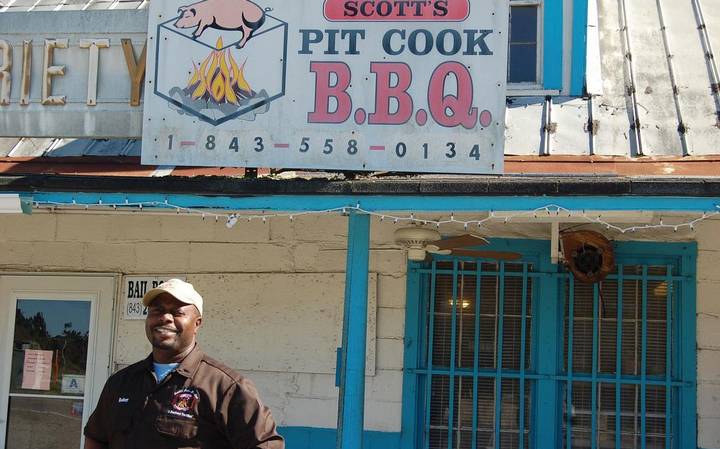When I was a little girl, there weren’t many places to get barbecue in Columbia. Barbecue was more of a destination meal. You had to drive, in my family’s case, way across town – from Dentsville to West Columbia – to get to Maurice’s Piggie Park on the Charleston Highway.
If we were headed in the opposite direction, towards Sumter to visit relatives, we always found a way to stop at Ward’s, near Swan Lake, to pick up a couple of pounds of barbecue on the way home. So, for me, barbecue has always been associated with a road trip.
Lake High Jr., president and co-founder of the South Carolina Barbeque Association and author of “A History of South Carolina Barbeque,” says much the same thing: back in the 1700s and 1800s, everyone would come to town on what was known as “court day.”
Barbecue was sold out of the back of wagons during the day so that the folks who had traveled to town would have something to eat. Then politicians began having rallies and meetings where people came. Barbecue was served and some of those spots evolved into barbeque joints. Those places – usually a short distance outside of town limits – were basically cinderblock buildings with nothing more than a counter for take-out service and maybe a crude table or bench to sit at while eating a sandwich.
As more and more people began seeking out good barbecue, these joints began to grow to meet demand and, to set themselves apart, became known for their signature sauces. Maurice’s was/is a mild, sweet yellow mustard; Hite’s along Dreher Road has a peppery yellow mustard for the pulled pork and a slightly sweet red sauce for the ribs. My first introduction to vinegar-pepper sauce came when a relative brought back barbecue from McKenzie’s near Florence (alas, it’s no longer there). That’s the one I fell in love with and I will drive to get a good vinegar-pepper barbeque when it’s done right.
That’s how I found Scott’s Bar-B-Que in Hemingway.
Even before The New York Times published a review of Scott’s, written by John T. Edge in 2009, if you asked anyone in that area around Hemingway or Lake City where to find great barbecue, you would be directed to Scott’s. Since The Times article, Rodney has become somewhat of a superstar in the barbecue world and a bridge between the old-school pitmasters and a younger generation just starting out.
And that new generation of barbecue folks is making Columbia its own pit stop for barbecue. The settings are far different – atop Five Points bars and near tailgating venues. Word of mouth is through social media. And they’re not afraid to try exotic combinations in their sauces or in their presentation.
the bridge
Rodney Scott grew up in the barbecue business, taking over from his parents in 2011 (his dad still helps with the wood and the sauce). His barbecue is consistently voted – if not the best – then Apple Block Party. He was pitmaster at the prestigious international Cook it Raw event in Charleston in 2013, and has traveled the globe cooking and learning and trading tips with professional chefs.
He has “refined” his sauce a bit since seeing how some ingredients, especially the citrus, affect the tenderness of the meat and he “pays more attention to the meat, especially when to take it off the fire.”
He’s observed that many culinary chefs are returning to fire and smoke, burning wood down to ash to feed restaurant smokers and ovens – just as he does in Hemingway. And some chefs, maybe because of the trend of nose-to-tail dining, are going back to whole hog.
“People appreciate the whole hog more. The work involved. They recognize that it’s a big deal,” says Scott. “A whole hog can feed a lot of people with small portions (when catering, for instance). About 100 people, average. And it’s much easier on the protein side (of planning and preparation).”
But he adds, “a lot of critics start thinking ‘I can do it (barbecue) too’ and are finding out the hard way that it’s not easy.”
Word of mouth is gold to a barbecue joint. The new guys are adept at using social media (Twitter, Instagram and Facebook) to get their word out and to show off their latest creations: Rodney Scott has just under 3,000 followers on Twitter (@rodneyscottbbq), Maurice’s has 631 (@PiggiePark), Yellow Dog BBQ has 364 (@YellowDogBBQ) and Southern Belly has 487 (@southern-belly) – enough to share any mouth-watering news.
the new generation
Jimmy Phillips, who owns Southern Belly along Rosewood Drive in Columbia, has a deep devotion to the traditional way of cooking pork – low and slow with little seasoning. Phillips’ niche is to do the meat consistently well one way and then experiment with a number of sauces. His set menu include seven basic sauces – everything from a variation of the traditional sweet yellow mustard (Midas) or a spicy tomato (Sherman) to an Alabama white (Southern Bell-y) or an “Asian-infused funky remoulade (Yum Yum).”
“To some, the use of different ingredients and experimenting with flavor of the sauce is not barbecue,” said Phillips. “But I think it’s about being creative and having fun with it.”
At Southern Belly, you can still get a basic pulled pork sandwich – the Boston butts have been cooked low and slow for 12 hours before being placed in the smoker out back for finishing with hickory and oak wood smoke (sometimes he or his kitchen staff will add apple, pecan or cherry for a sweeter depth of flavor).
Or you can try a sandwich combination off the menu (the King Kahuna features pork with pineapple, grilled Maui onions, cheddar and applewood bacon, served on Hawaiian sweet bread with Yum Yum sauce). Or you can create a sandwich by selecting your sauce and optional toppings (Applewood bacon, roasted red peppers, grilled Vidalia onions, etc.) and/or cheese.
For a recent Monday special, the kitchen put out a sandwich called the Brie-B-Q – melted brie, apples, toasted almonds and apricot marmalade on a French roll.
The unifying ingredient is always the pulled pork.
That creativity – or rather the need to express his own creative streak – is what led Will Lacey into the kitchen. Lacey, who owns Yellow Dog Barbeque, began learning the art of grilling early while spending summers at an aunt’s home on Edisto Island.
After seeing how much friends and family appreciated his creativity and use of local ingredients at Sunday dinners and family get-togethers, Lacey decided to start taking things a bit more seriously. He loves competition, so he started on the barbecue circuit in 2012, entering the Commissioner’s Cup and Chefs on the Shoe competitions for a couple of years. He credits Lou Hutto, of LowCo Barbecue & Catering in Columbia, for teaching him how to cook a brisket – beef is becoming common on the Southern barbeque menu – and Lacey now incorporates that into his menu that is served nightly at Punch and The Attic in Five Points.
How he got that gig is a good story: Lacey, admittedly not one to shy away from attention, started Instagramming shots of his culinary experiments. Ryan Kay, owner of Pinch, saw Lacey’s photos and contacted him and the rest, as they say, is history.
Lacey and Hutto have set up a smoker on the roof where Lacey takes it low and slow with the chickens, pork and beef. He uses pecan wood, “it’s a bit nostalgic and a tribute to South Carolina,” he says.
On Thursday nights, Lacey sets a special menu for The Attic, pairing a new barbecue creation with a local craft brew. When I was there, Lacey prepared a version of arancini (Sicilian stuffed rice balls that are then battered and deep fried) with Charleston red rice mixed with pulled pork, cheddar cheese, chili powder and peppers. The rice mixture was formed into fist-size balls, rolled in bread crumbs and fried and served with tomato jam and his yellow mustard sauce. It was delicious.
Saturdays feature smoked wings, St. Louis-style ribs and a burnt ends sandwich (burnt ends, to barbeque connoisseurs, are the best part of the brisket, the slightly crunchy end slices off a whole brisket).
“We live in a restaurant culture,” says Lake High. “Everyone wants to eat out. (This new generation) is a logical evolution, you’ve got to do something different.”
taking a look back
Hite’s along Dreher Road in West Columbia is a third-generation family business. Take-out only, David Hite’s grandfather started the barbecue stand in 1957 and his parents ran the business until three years ago when David took over in 2012.
David recalls starting in the business while he as still in high school, having to start work after school and work in the pits until midnight, making sure the fires were stoked and that the meats were turned and hash prepared. His high school buddies would come over after football games to celebrate at “the BBQ House” because it was safe and well lit. Then, when his father became ill, he took over the midnight to morning shift, getting off work at 7 a.m., with just enough time to take a nap and get cleaned up before the store opened at 9 a.m.
Getting ready for a regular weekend, Hite will begin cooking at 2 p.m. Wednesday. For Friday and Saturday service, he will go through two whole hogs, 30 hams, 300-400 chickens, 160-190 pounds of spare ribs and 60 gallons hash. For the Fourth of July, Hite will cook 300 hams; 6 hogs; 1,000 chickens; 800-1,000 pounds of ribs and 500-600 gallons of hash.
“We’re open three days this year (for the Fourth of July weekend). The pits that line both sides of the cinderblock building will be going all day. You can only cook so much at one time and it’s all day long. “It gets so smoky you can’t see across the room for 18 hours straight. The smoke and the heat is unbearable, and there’s nothing fun about it except the profit at the end of the day,” Hite said.
His customers, who are older, tend to prefer the leaner hams so he will mix two shoulders off the hog with the pulled smoked ham.
Hite’s, too, has had their share of national attention. The business has been written up by Esquire and Garden & Gun magazines and, like Scott’s, is consistently mentioned as one of the best in the state.
One thing David has noticed over the years is the change in customer habits and how those habits affect his business. His older customers normally buy in bulk: a pound of meat, a whole chicken or a gallon of hash, take it home and eat a bit of it and save the rest for a later meal. The younger crowd tends to purchase plates of single servings of meat with sides, which might be saved or more likely tossed after a meal. He says he sells three times as many plates now as did just five years ago.
The cooking process at Hite’s is the same as it was in 1957. And that process still has a following. David’s sister, Angie Hite, speaks of young couples who come in and order at the counter and tell her stories of how they came in when they were children with their parents and grandparents. Or of the two sisters who would set up lawn chairs in the parking lot hours before Hite’s opened for the Fourth of July so that they could be first in line.
And of the lines that form along Dreher Road on holiday weekends … waiting … for barbecue.
THE NEW GENERATION
They’re young and creative … and know how to do it low and slow
▪ They don’t rely on a single sauce
▪ They experiment with presentation (think nachos, pizzas, etc)
▪ They rely heavily on social media to build the business
THE NEW GENERATION, PART II
Mobility is the word when it comes to these guys, the BBQ truckers
Bone-In Artisan Barbeque on Wheels, follow on Facebook or Twitter @artisanbbqtruck
The BBQ Bus (Size Matters), follow on Facebook or Twitter @Sizemattersbbq
Casey’s Big Dawg BBQ & Barkmobile, follow on Facebook



